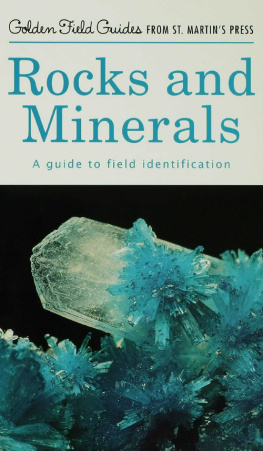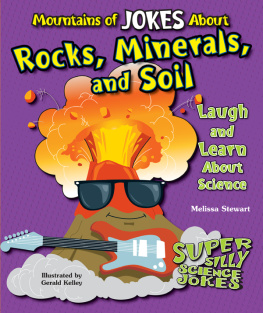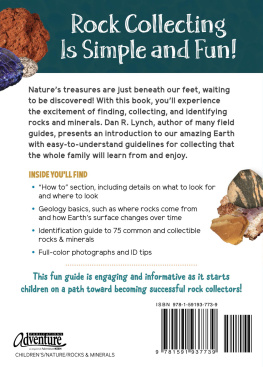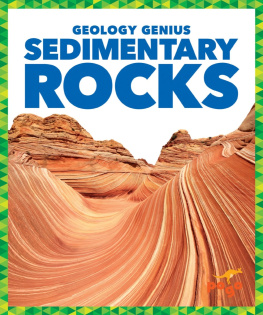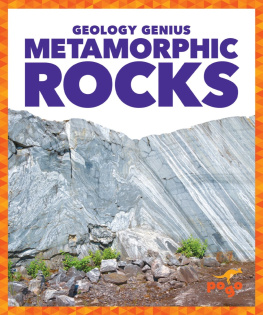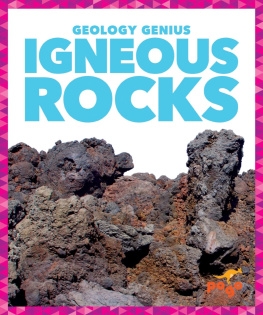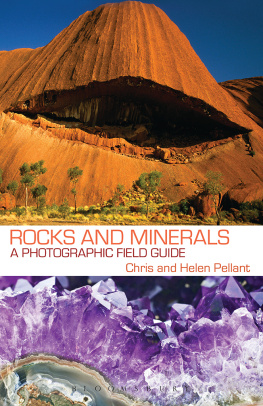A FIELD GUIDE AND INTRODUCTION TO
THE GEOLOGY AND CHEMISTRY OF
ROCKS AND MINERALS
a Golden Field Guide from St. Martins Press
Original Title: MINERALS OF THE WORLD
by
CHARLES A. SORRELL
Research Geologist
Avondale Research Center
U.S. Bureau of Mines
Illustrated by
GEORGE F. SANDSTRM
Original Project Editor: HERBERT S. ZIM

Cinnabar
Piute Co., Utah

The author and publisher have provided this e-book to you for your personal use only. You may not make this e-book publicly available in any way. Copyright infringement is against the law. If you believe the copy of this e-book you are reading infringes on the authors copyright, please notify the publisher at: us.macmillanusa.com/piracy.
FOREWORD
Of all the objects of nature, minerals are among the most readily available for study and, because of their immense variety and intrinsic beauty, have always been items of interest and curiosity. This book was written to fill the gap between available popular books and the typical college textbook; it emphasizes chemical relationships and crystal structures with some introduction to rocks and their geologic relationship to major rock types. The hundreds of full color illustrations provide the mineral enthusiast with a reference catalog for identification not available in any other book.
Without the generous cooperation of many individuals, the illustrations for this guide could not have been prepared. We are therefore indebted to Dr. James E. Bever of Miami University, Oxford, Ohio and to Dr. John C. Butler and Dr. George Distler, who, during their graduate studies, assisted with the selection of specimens from the Miami University geology collection. Wards Natural Science Establishment, Rochester, New York, was helpful in providing several specimens on loan, and Dr. Kerry Grant, University of Missouri-Rolla generously made available their geology collection.
Generous help, advice and full cooperation, especially in obtaining and identifying needed specimens, was given the artist by the staff of the Geology Department of Bryn Mawr College, Bryn Mawr, Pennsylvania, under the chairmanship of Associate Professor, Lucien B. Platt. Special mention and gratitude is expressed to Professor Emeritus of Geology and Research Associate, Edward H. Watson; Assistant Professor of Geology, William A. Crawford and Maria Luisa Crawford (Curator); and Assistant Curator, Harold W. Ardnt, who unselfishly gave much of his time in locating needed specimens. Recognition is also due Edward McHale (deceased). Specimens supplied to the artist by Bryn Mawr College came from the George S. Vaux and Theodore Rand collections.
The artist is also grateful for the helpful advice and cooperation, received at the beginning of this project, from Paul Seel and Walter Groff (deceased), both amateur mineralogists.
C.A.S
G.S.F.
ROCKS AND MINERALS. Copyright 1973 by St. Martins Press. All rights reserved. No part of this book may be used or reproduced in any manner whatsoever without written permission except in the case of brief quotations embodied in critical articles or reviews. For information, address St. Martins Press, 175 Fifth Avenue, New York, N.Y. 10010. www.stmartins.com
Golden Field Guide is a trademark of Golden Books Publishing Company, Inc., used under license.
eISBN 978-1-4668-6483-2
MINERALOGY AS A SCIENCE
Minerals are the natural crystalline materials that form the Earth and make up most of its rocks. Though minerals have been used and metals extracted from them for all of recorded history, mineralogy as a science is relatively young. Serious study of minerals began in the 1800s, after the development of the petrographic microscope (for studying rocks) and the reflecting goniometer (for accurately measuring angles between faces of a minerals crystals). During that century most of the minerals known today were described, optically studied, and chemically analyzed. Largely from these studies grew the schemes used today to classify minerals. The internal crystal structure of minerals, however, could only be guessed from their external symmetry and optical properties.
Wilhelm Roentgens discovery of X-rays in 1895 provided mineralogists with the tool they needed to study crystal structures, but it was not until 1912 that Max von Laue and his assistants proved that when X-rays are scattered by a crystal their behavior gives clues to the internal arrangement. Since then, the structures of all important mineral groups have been analyzed. By correlating this structural knowledge with physical, chemical, electrical, thermal, and mechanical properties, mineralogists have gained an understanding of the forces that hold crystalline matter together. This understanding has in turn enabled scientists to synthesize crystalline compounds with properties to fill special needs. These compounds have been used in the manufacture of high-temperature ceramics, electrical insulators, transistors, and many other items.
Knowledge of the behavior of crystals at high temperatures and pressures has been applied to research on the formation of mountains, the eruption of volcanoes, and other geologic processes. The forces that cause these activities become more understandable when analyzed in terms of structural changes in the mineral components of rock.
Rocks, metals, concrete, bricks, plaster, paint pigments, paper, rubber, and ceramics all contain mineral or synthetic crystals. In fact, almost all solids except glass and organic materials are crystalline. This is why knowledge of the structure and behavior of crystals is important in nearly all industrial and technical endeavors. Even organic materials form crystals when isolated in a pure state. By studying these crystals, biologists and medical researchers have learned much about life processes and heredity.
Unquestionably mineralogy is a subject of widespread importance in all of science. Consequently, persons trained in mineralogy and crystallography may be found doing work in the parent science, geology, or may be engaged in research in metallurgical, ceramic, or polymer materials, in solid state physics or chemistry, or in the biological sciences. Interdisciplinary cooperation among scientists has led to many important discoveries.
MINERALS IN ROCKS
Minerals are the constituents of rocks, which make up the entire inorganic, solid portion of the earth. Mineral formation and rock formation are, in fact, one process. To know minerals, therefore, it is important to know rocks. A single mineral may form a rock, but usually rocks are cohesive aggregates of two or more minerals. Depending on how they were formed, rocks are divided into three types: igneous, metamorphic, and sedimentary.
IGNEOUS ROCKS are formed by the cooling and hardening of magma, a complex molten material that originates within the earth. Some important types of igneous rocks are shown in the illustration on the facing page. The major mineral constituents of acid, intermediate, and basic rocks shown provide the basis for the classification given .
IGNEOUS MINERALS important in the formation of igneous rocks are relatively few in number. This is because the magma from which the minerals crystallize is rich only in certain elements: silicon, oxygen, aluminum, sodium, potassium, calcium, iron, and magnesium. These are the elements that combine and form the . A limited number of the silicatesthe olivines, pyroxenes, amphiboles, micas, feldspars, and quartzaccount for over 90 percent of all igneous rocks.

